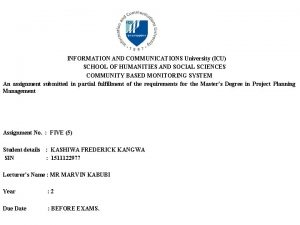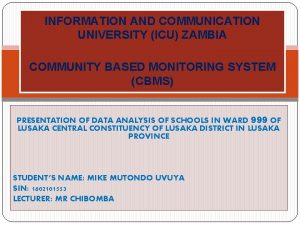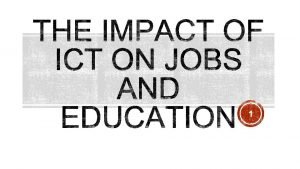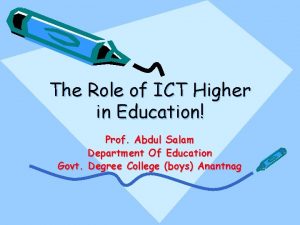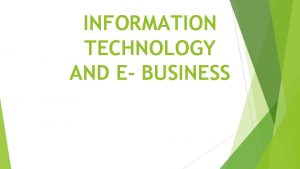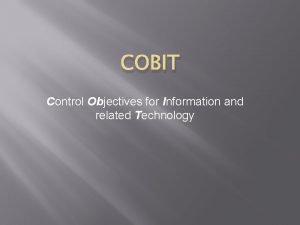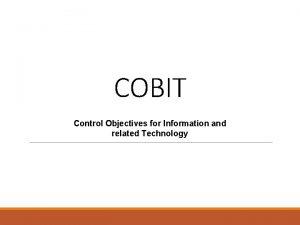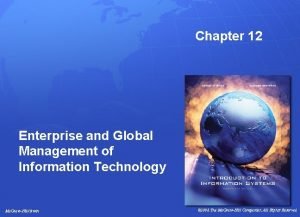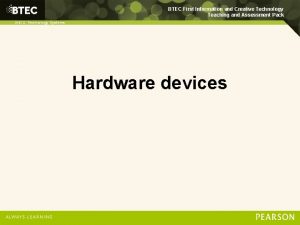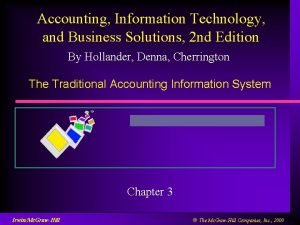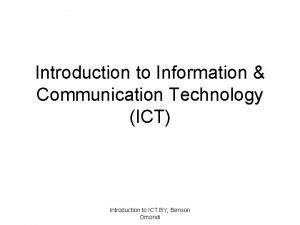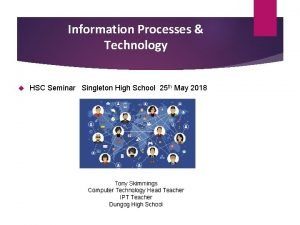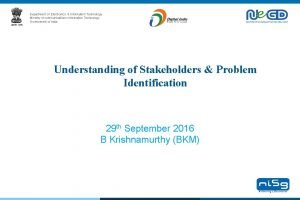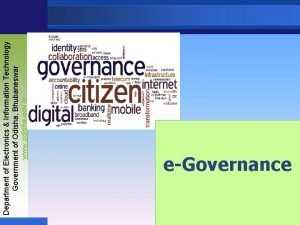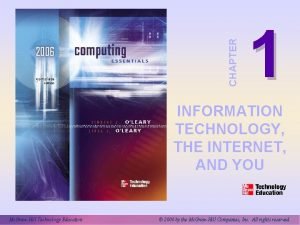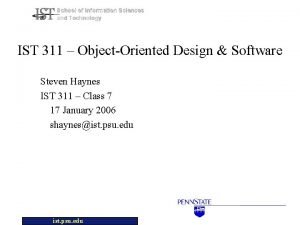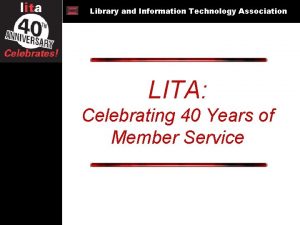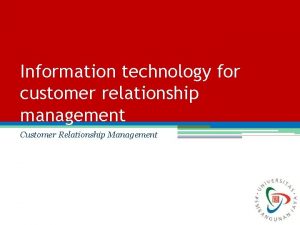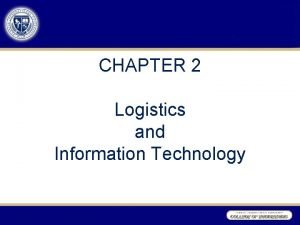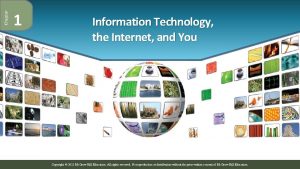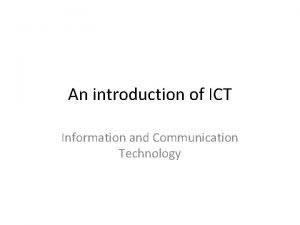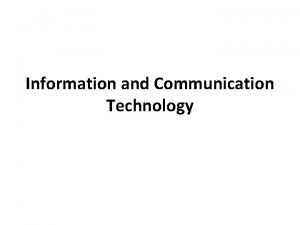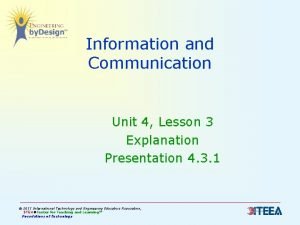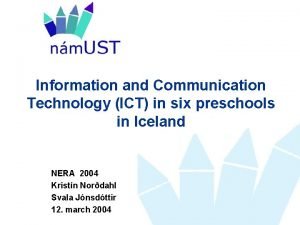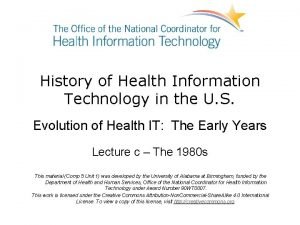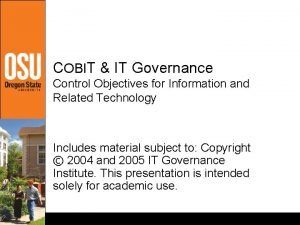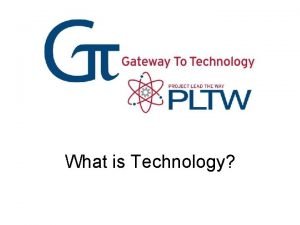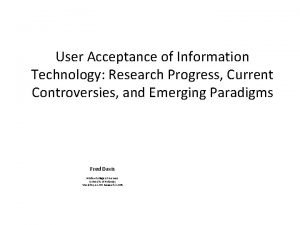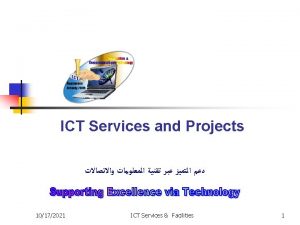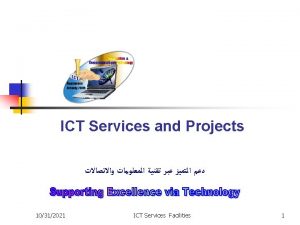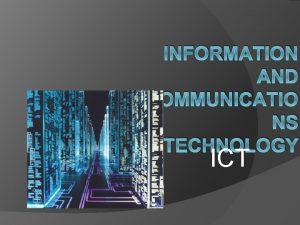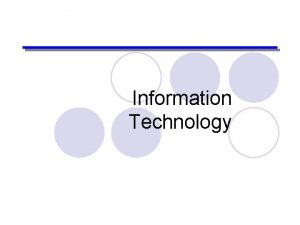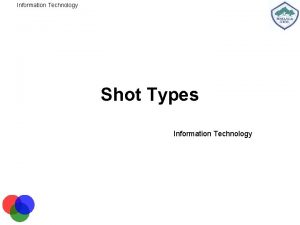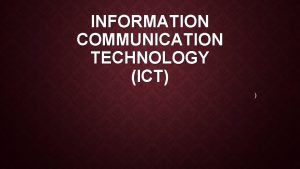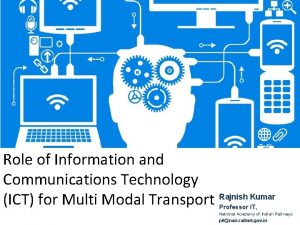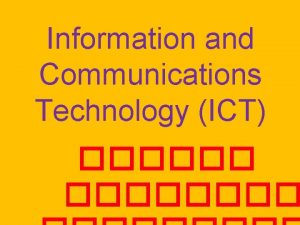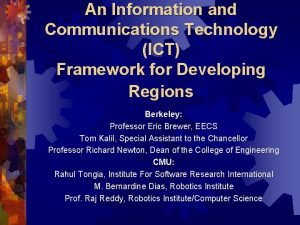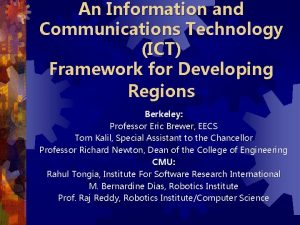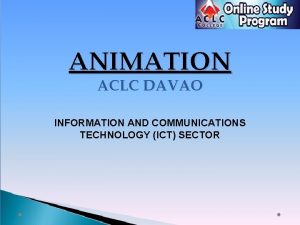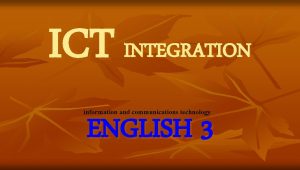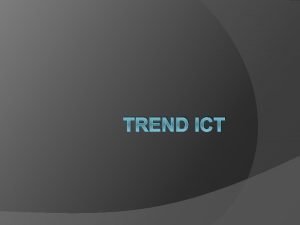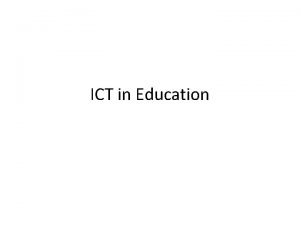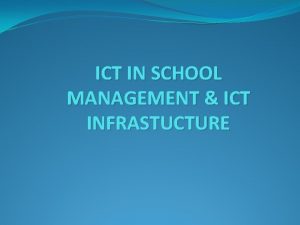1 What is Information and Communications Technology ICT



































- Slides: 35

1

ü What is Information and Communications Technology (ICT)? ü The impact of ICT on Job Security ü assess the effect of automation on job security; ü Computer-related professions ü describe the roles of various personnel in computer-related professions ü ICT in Education ü assess the impact of information and communications technology on education ü ICT in Medicine ü assess the impact of information and communications technology on medicine ü Other important trends in technology 2

§ Information Technology (IT) can be defined as the applications of systems – both computers and telecommunications- to retrieve, manipulate and transmit data, often within a business context. § ICT refers to technologies that provide access to information through telecommunications. § It is similar to Information Technology (IT), but focuses primarily on communication technologies. This includes the Internet, wireless networks, cell phones, and other communication mediums. 3

§ What is automation? § Automation is the technology by which a process or procedure is performed without human assistance. § Automation or automatic control is the use of various control systems for operating equipment such as machinery, processes in factories, steering and stabilization of aircrafts, and other applications with minimal or reduced human intervention. 4

Advantages Disadvantages § Higher production rates and increased § Loss of Jobs. productivity § More efficient use of materials § Leads to emotional stress for workers § Better product quality 5

§ Computer network architect § computer programmer § computer support specialist § computer systems analyst § network and computer systems administrator § database administrator § software developer § web developer 6

§ Computer Network Architects develop data communication networks, including intranets, wide area networks (WANs), local area networks (LANs). § These networks can be as simplistic as a single connection between a few offices to a complex wide area network used to support a multinational corporation with hundreds of offices across the globe. 7

§ A programmer, developer, or software engineer is a person who creates computer software. § The term computer programmer can refer to a specialist in one area of computers or to a generalist who writes code for many kinds of software. 8

§ A computer support specialist assists users who are having problems with software, computers or peripherals such as printers or scanners. 9

§ Computer systems analysts, sometimes called systems architects, study an organization’s current computer systems and procedures, and design solutions to help the organization operate more efficiently and effectively. § They bring business and information technology (IT) together by understanding the needs and limitations of both. § A systems analyst is responsible for researching, planning, coordinating and recommending software and system choices to meet an organization’s business requirements. § A systems analyst performs the following tasks: § Interact with the customers to know their requirements § Interact with designers to convey the possible interface of the software § Interact/guide the coders/developers to keep track of system development § Perform system testing with sample/live data with the help of testers § Implement the new system § Prepare High quality Documentation 10

§ Network and computer systems administrators are responsible for the day-to-day operation of an organization's computer networks. § They organize, install, and support an organization’s computer systems, including local area networks (LANs), wide area networks (WANs), network segments, intranets, and other data communication systems. 11

§ Database administrators (DBAs) use specialized software to store and organize data, such as financial information and customer shipping records. § They make sure that data are available to users and secure from unauthorized access. § The role may include capacity planning, installation, configuration, database design, migration, performance monitoring, security, troubleshooting, as well as backup and data recovery. 12

§ Software developers are the creative minds behind computer programs. § Some develop the applications that allow people to do specific tasks on a computer or another device. Others develop the underlying systems that run the devices or that control networks. 13

WEB DEVELOPER § A web developer is a programmer who specializes in, or is specifically engaged in, the development of World Wide Web applications, or applications that are run over HTTP from a web server to a web browser. 14

ICT IN EDUCATION § This refers to teaching and learning with ICT. § ICT has provided many advantages in the field of Education such as: § Providing easy access to a wealth of information for both teachers and students. § Expanding the access to education (distant teaching or Distance Education). § Online tutoring (E Learning) § Allows for collaborative teaching and learning to take place easily. § Disadvantages of ICT in Education includes: § Plagiarism – due to the easy access to information, persons get very complacent and sometimes steal or accept credit for other people’s work. § Effective ICT systems are costly to setup and maintain. 15

§ Distance learning, also called distance education, and online learning is a form of education in which the main elements include physical separation of teachers and students during instruction and the use of various technologies to facilitate studentteacher and student-student communication. 16

§ Collaborative learning is a method of teaching and learning in which students team together to explore a significant question or create a meaningful project. § A group of students discussing a lecture or students from different schools working together over the Internet on a shared assignment are both examples of collaborative learning. 17

§ Like Education, the advancement of technology has also impacted the field of medicine. Some positive impacts include: § Easy access to a wealth of information by both § § § § practitioners and patients. Telemedicine - Telemedicine is the use of telecommunication and information technology to provide clinical health care from a distance. E-Heath Information sharing is easier. This means that doctors and other health care professionals can easily share information on how to handle certain cases. Improved quality of healthcare as information is easily accessed by practitioners. Lower costs for patients, as travelling is somewhat reduced. Increase in self-diagnosis. Easy access to medical expertise in distant locations for example teleradiology. 18

§ e. Health is a broad term, and refers to the use of information and communications technologies in healthcare. § The World Health Organization (WHO) defines e. Health as: § “. . . the cost-effective and secure use of information and communication technologies in support of the health and health-related fields including healthcare, health surveillance and health education, knowledge and research. ” § Depending on how people choose to define it, e. Health encompasses a wide variety of sub-domains of digital health such as: § Electronic Health/Medical Records § Telehealth and telemedicine § Health IT systems § Virtual healthcare § Mobile Health (m. Health) 19

§ Teleradiology is the transmission of radiological patient images, such as x-rays, CTs, and MRIs, from one location to another for the purposes of sharing studies with other radiologists and physicians. § Teleradiology improves patient care by allowing radiologists to provide services without actually having to be at the location of the patient. § This is particularly important when a sub- specialist such as a MRI radiologist, neuroradiologist, pediatric radiologist, or musculoskeletal radiologist is needed, since these professionals are generally only located in large metropolitan areas working during daytime hours. Teleradiology allows for trained specialists to be available 24/7. 20

21

§ Also refers to as “remote work” or working remotely with. It enables an employee to manipulate and interact with files, documents and folders that is exclusively available on their company’s network through a private communication channel. § Advantages of telecommuting § Reduces transportation cost. § Reduces stress induced by traffic. § Disadvantages of telecommuting § Increase in telephone and electric bill. § Setup cost. § Lack of employee supervision. § Develop poor human interactive skills. 22

§ This is a marketing strategy which involves connecting with consumers over the telephone. § The most obvious form of telemarketing involves company calls to individuals at home to tell them about products, telemarketing is also a significant strategy in business-to-business sales, event promotion and even political campaigning. 23

§ Videoconferencing refers to using computer related devices and features (video and audio) to allow individuals in different geological locations to simultaneously see and hear each other. 24

§ Teleconferencing is the use of computer related devices and features (audio ONLY). It allows individuals in different geological locations to simultaneously hear each other. § Advantages of Teleconferencing and Videoconferencing § Conveniences § Productivity gain § Reduce travel time and cost § Disadvantages of Teleconferencing and Videoconferencing § Telecommunication cost § Poor human interaction skills § Slow or poor feeds 25

§ E-Commerce is the buying and selling of goods and services by utilizing an electronic device which has access to the internet to complete the transaction. Example: shopping on Amazon § Advantages of E-commerce § Browsing vast and multiple online stores for products are appealing. § Shopping from the comfort and safety of your home. § New and exclusive features § Disadvantages of E-commerce § Identity Theft § Goods might be incorrect § Goods might not work properly upon arrival 26

§ N. L. P is an evolving feature in most modern computers which enables computers to understand or execute instructions given by users, in natural human language and not computer language. 27

§ Voice Synthesis refers to an electronic device which is able to imitate human voice. § Examples; siri, google now, Cortana and others. 28

§ This is the use of a various application software, computers and high-quality § printers to making newsletters, booklets and fliers. 29

§ This is the usage of computer software to aid in engineering analysis tasks. § For example, CAE is widely used in the automotive industry, the use of such tools has enabled the automakers to reduce product development cost and time while improving the safety, comfort, and durability of the vehicles they produce. 30

§ This is the use of computer systems to aid in the creation, modification, analysis, or § optimization of a design. 31

§ These are Computer Aided Design systems (CAD) with additional drafting features. § Technical drafting or drawing is the act of creating drawings that communicate how something functions or how it is to be constructed. 32

§ This is the use of software to control physical machine tools to facilitate and automate manufacturing processes. CAM uses computer-driven manufacturing processes for additional automation of management, material tracking, planning and transportation. § Advantages of CAM 1. With the aid of CAM, the waste produced during manufacturing processes is reduced. 2. Less energy is used during the manufacturing process. 3. Increased production speeds. That is, CAM facilitates a quicker transition between raw material and the finished product. 33

§ Expert systems are computer programs that are derived from an area of computer science research called Artificial Intelligence (AI). § The term expert system is reserved for computer programs whose knowledge base contains the knowledge used by human experts. § Expert systems can be described as software programs that utilizes databases of expert knowledge to offer advice or make decisions. 34

§ A robot is a mechanical or virtual artificial agent, usually an electromechanical machine that is guided by a computer program or electronic circuitry. § Robots are widely used in various industry to make life easier and also to speed the manufacturing of products. 35
 Track and report nims
Track and report nims Information and communications university
Information and communications university Information and communication university
Information and communication university What is information
What is information Ict conclusion
Ict conclusion Media literacy and information literacy
Media literacy and information literacy Discuss about information technology and e-business
Discuss about information technology and e-business Examples of current media and information technology
Examples of current media and information technology Control objectives for information and related technology
Control objectives for information and related technology Control objectives for information and related technology
Control objectives for information and related technology Enterprise and global management in mis
Enterprise and global management in mis Btec first engineering teaching and assessment pack
Btec first engineering teaching and assessment pack Accounting information technology and business solutions
Accounting information technology and business solutions Memes about media and information literacy
Memes about media and information literacy Introduction of ict
Introduction of ict Hsc multiple choice generator
Hsc multiple choice generator Ministry of electronics and information technology
Ministry of electronics and information technology It department odisha
It department odisha Chapter 1 information technology the internet and you
Chapter 1 information technology the internet and you College of information sciences and technology
College of information sciences and technology Library and information technology association
Library and information technology association Information technology and customer relationship management
Information technology and customer relationship management Information and communication technology capability
Information and communication technology capability Logistics information technology
Logistics information technology Chapter 1 information technology the internet and you
Chapter 1 information technology the internet and you Introduction of ict
Introduction of ict Prosofit
Prosofit Meaning of information and communication technology
Meaning of information and communication technology Components of information and communication technology
Components of information and communication technology Definition information and communication technology
Definition information and communication technology History and evolution of health information technology
History and evolution of health information technology Control objectives for information and related technology
Control objectives for information and related technology Materials technology positive impacts
Materials technology positive impacts Positive impacts of information technology
Positive impacts of information technology Volvo information technology ab
Volvo information technology ab User acceptance of information technology
User acceptance of information technology

